eCommerce Analytics: Using Data to Grow your Business

Gain valuable insights into customer behavior and preferences with ecommerce analytics. Analyzing online marketing and sales data can provide valuable information about customer behavior and preferences, helping businesses optimize their online shopping experience. By leveraging ecommerce analytics tools and utilizing predictive analytics, you can optimize your ecommerce business’s performance and drive growth by analyzing ecommerce metrics. With web analytics and data analytics, you can track key metrics to measure the success of your online marketing strategy. This allows you to make informed adjustments as needed for your ecommerce strategy. Ecommerce analytics provides valuable page insights, including main and performance metrics, which can help you identify areas for improvement based on user behavior data. This will help you understand how visitors interact with your website and optimize the user experience. With the right ecommerce analytics tools, you can streamline purchasing and increase conversion rates. Discover how to effectively leverage ecommerce analytics tools and web analytics data to stay ahead of the competition in today’s digital marketplace.
On this page:
Using Data to Drive Sales Growth
Analyzing sales data is crucial for any ecommerce business looking to drive sales growth. Implementing e-commerce analytics allows businesses to track and analyze data related to conversion rate and better understand consumer behavior. By examining the data, businesses can identify trends and patterns that provide valuable insights into customer behavior and preferences and understand how people interact with their websites. This ecommerce data analytics information can be used to make informed decisions and optimize various aspects of the business, from marketing efforts to pricing strategies.
Analyze sales data to identify trends and patterns
One of the key benefits of ecommerce analytics for businesses is the ability to analyze sales data on the web to identify trends and patterns. This information can be used to generate a comprehensive report providing valuable insights. By examining historical sales performance using web analytics and ecommerce data, businesses can better understand what products are popular among customers, which ones are underperforming, and how consumer preferences may change over time. With this knowledge, businesses can use web analytics to make data-driven decisions about product offerings, marketing campaigns, and inventory management. The tool provides a report on the relevant data. Pros:
- Helps businesses understand customer demand.
- Enables proactive decision-making based on market trends.
- Allows businesses to stay ahead of competitors by identifying emerging opportunities through a report.
Cons:
- Requires access to accurate and comprehensive sales data.
- May require additional resources or expertise in data analysis.
- Can be time-consuming if not automated.
Use customer segmentation to personalize marketing efforts
Another powerful application of ecommerce analytics is customer segmentation. Businesses can tailor their marketing efforts by dividing customers into distinct segments based on their demographics, behavior, or purchase history. This segmentation allows businesses to create targeted marketing strategies and campaigns that are more effective in reaching their intended audience. Additionally, businesses can use this data to generate a detailed report on customer preferences and trends, which can inform future marketing decisions and initiatives. Personalized marketing messages have significantly improved business engagement and conversion rates. Pros:
- Increases the business effectiveness of marketing campaigns by targeting specific customer segments, resulting in a more targeted and efficient approach. This can be achieved through a comprehensive business report that analyzes customer data and identifies key segments for targeting.
- Enhances the overall customer experience by delivering relevant content.
- Improves business customer retention rates by fostering a sense of personalization, according to the latest report.
Cons:
- Requires access to detailed customer data points.
- May require investment in marketing automation tools or software.
- Needs ongoing analysis and adjustment to ensure accuracy and relevance.
RELATED: Website Personalization Strategies to improve Conversation Rates
Optimize pricing strategies based on historical sales data
Ecommerce analytics can also provide valuable insights into pricing strategies. By analyzing historical sales data, businesses can identify price points that maximize revenue while remaining competitive. This information allows businesses to optimize their pricing strategies by adjusting prices based on customer demand, seasonality, or competitor analysis. Pros:
- Maximizes revenue potential by setting optimal price points.
- Helps businesses stay competitive in the market.
- Enables dynamic pricing strategies based on real-time data.
Cons:
- Requires access to accurate and up-to-date sales data.
- May require continuous monitoring and adjustment of prices.
- Can be challenging to balance profit margins with customer expectations.
Leverage analytics to improve inventory management and reduce costs
Effective inventory management is crucial for ecommerce businesses to reduce costs and ensure customer satisfaction. Ecommerce analytics provides valuable insights into inventory performance, allowing businesses to make data-driven decisions about stock levels, replenishment schedules, and warehouse operations. By optimizing inventory management, businesses can reduce carrying costs, minimize stockouts or overstock situations, and improve overall operational efficiency. Pros:
- Reduces carrying costs by eliminating excess inventory.
- Minimizes stockouts or overstock situations through better forecasting.
- Improves order fulfillment rates and enhances customer satisfaction.
Cons:
- Requires integration between the ecommerce platform and inventory management system.
- May require investment in inventory management software or tools.
- Needs ongoing monitoring and adjustment as business needs change.
RELATED: Maximizing your Ecommerce Success with a Reliable Fulfillment Network
Top 9 eCommerce Analytics Tools for 2023
Google Analytics

- Real-time analytics and detailed reports.
- Goal tracking and e-commerce analytics.
- Integration with other Google tools.
Pros:
- Free version available.
- User-friendly interface.
- Extensive online resources and community support.
Cons:
- Limited customer support for free users.
- Complex for advanced users seeking specific insights.
- Data privacy concerns.
For more information, visit https://analytics.google.com/
Kissmetrics
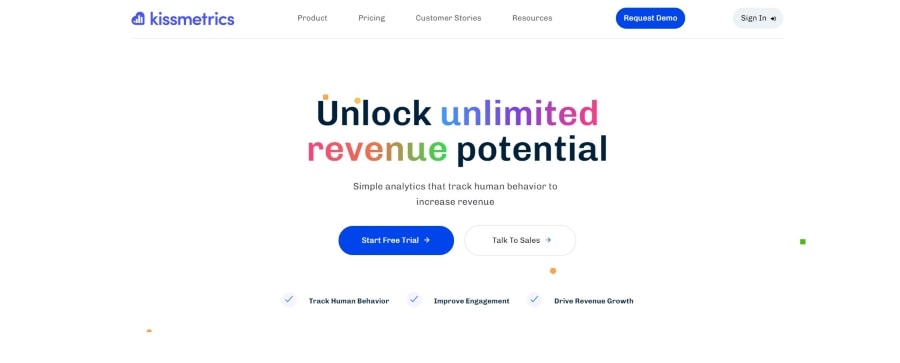
- Customer journey tracking and segmentation.
- A/B testing and funnel analysis.
- Email automation and behavioral targeting.
Pros:
- Deep insights into user behavior.
- Customer-focused analytics for retention and engagement.
- Integration with other marketing tools.
Cons:
- Pricing can be high for smaller businesses.
- Learning curve for complex features.
- Limited real-time reporting.
For more information, visit https://www.kissmetrics.com/
Mixpanel
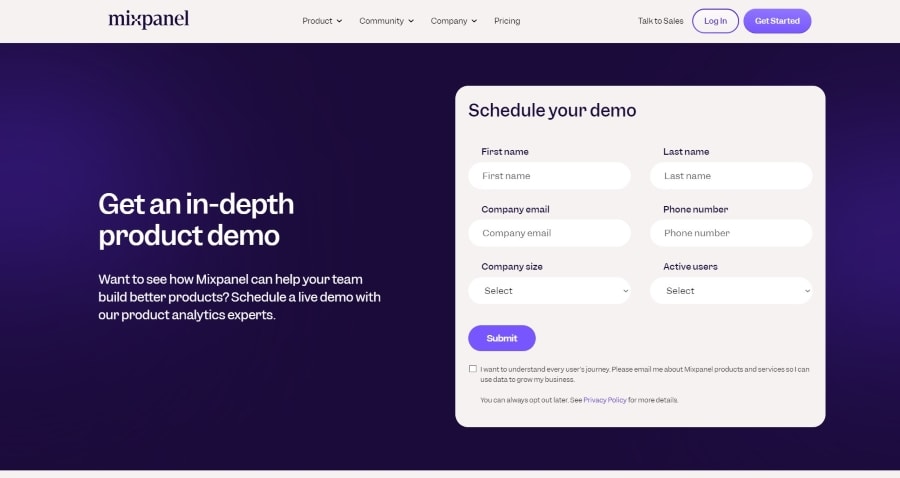
- Event tracking and user segmentation.
- Retention analysis and cohort reporting.
- A/B testing and messaging campaigns.
Pros:
- Focus on user events for deep insights.
- Powerful retention and engagement analysis.
- User-friendly interface.
Cons:
- Pricing can be expensive for high-volume websites.
- Limited e-commerce tracking features.
- Some features require technical expertise.
For more information, visit: https://mixpanel.com/
Hotjar
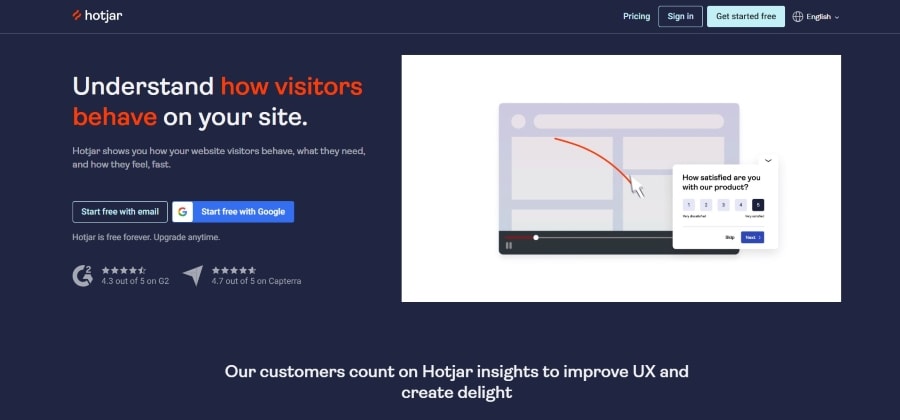
- Heatmaps, session recordings, and conversion funnels.
- On-site surveys and feedback collection.
- Visitor feedback and analysis tools.
Pros:
- Affordable pricing.
- Easy to set up and use.
- Effective at collecting user feedback.
Cons:
- Limited depth of analytics compared to some competitors.
- May require integration with other tools for advanced analysis.
- Limited customization options.
For more information, visit: https://www.hotjar.com/
Adobe Analytics
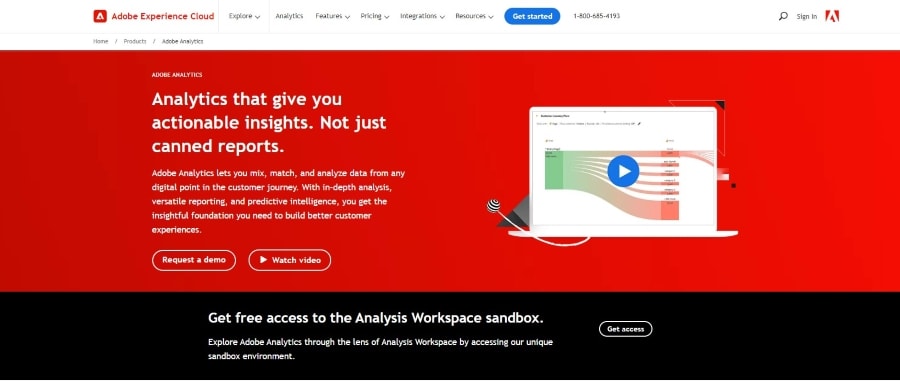
- Advanced segmentation and data visualization.
- Real-time analytics and predictive intelligence.
- Integration with Adobe Marketing Cloud for comprehensive marketing insights.
Pros:
- Scalability for large enterprises.
- Highly customizable reporting.
- Strong support and resources.
Cons:
- Steeper learning curve.
- Expensive for smaller businesses.
- Requires integration with other Adobe products.
For more information, visit: https://www.adobe.com/marketing/analytics.html
Shopify Analytics

- Sales and traffic reports.
- Customer behavior analysis.
- Integration with Shopify’s e-commerce platform.
Pros:
- Seamless integration for Shopify stores.
- User-friendly interface.
- Suitable for small to medium-sized e-commerce businesses.
Cons:
- Limited customization for non-Shopify users.
- May require third-party tools for advanced analytics.
- Less suitable for large enterprises.
For more information, visit: https://www.shopify.com/
Woopra

Woopra provides a holistic view of the customer journey across multiple touchpoints. It allows you to track and analyze user interactions across your website, mobile app, email campaigns, and more. By understanding the entire customer journey, you can optimize each touchpoint to drive conversions and increase customer satisfaction. Key Features:
- Real-time analytics and reporting.
- Customer journey tracking and segmentation.
- Integration with marketing and support tools.
Pros:
- Real-time insights for immediate actions.
- Focus on individual user journeys.
- Integration with various third-party tools.
Cons:
- Pricing may be higher for larger businesses.
- Complex for beginners.
- Limited depth of analytics compared to some competitors.
For more information, visit: https://www.woopra.com/
Piwik PRO
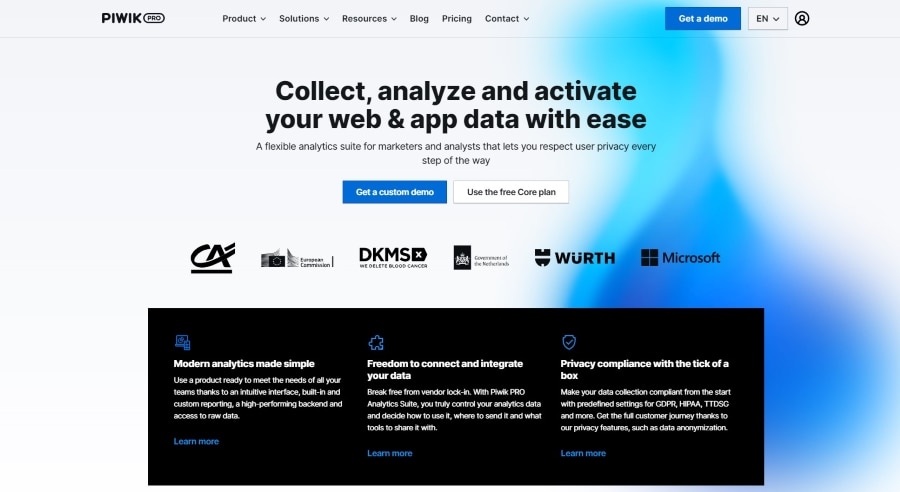
- On-premises and cloud-based deployment options.
- Advanced security and data ownership controls.
- Customizable analytics and reporting.
Pros:
- Strong data privacy and compliance features.
- Highly customizable and extensible.
- Suitable for large enterprises.
Cons:
- Costlier than some other solutions.
- Requires more technical expertise to set up.
- Limited third-party integrations.
For more information, visit: https://piwik.pro/
CrazyEgg
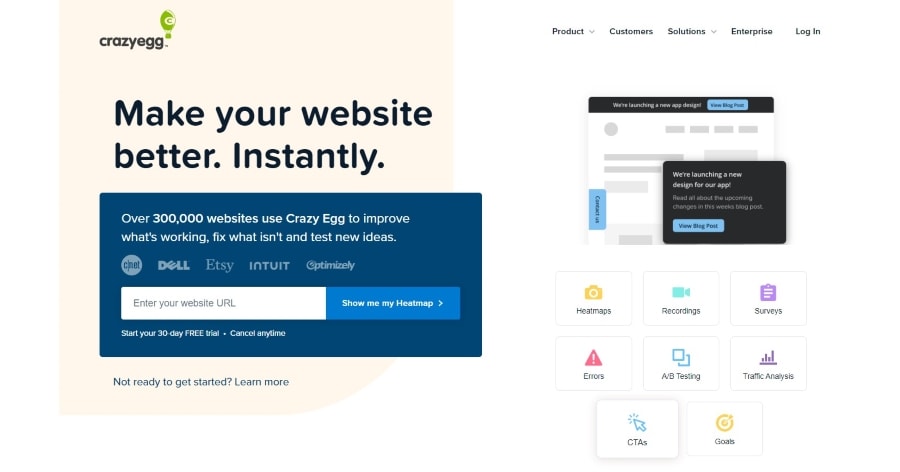
- Heatmaps for click and scroll tracking.
- User session recordings for behavior analysis.
- A/B testing and conversion rate optimization tools.
Pros:
- User-friendly interface.
- Quick setup and integration.
- Affordable pricing for small to medium-sized businesses.
Cons:
- Limited in-depth analytics compared to some competitors.
- May not be suitable for large enterprises.
- Lack of real-time reporting.
For more information, visit https://www.crazyegg.com/
Key Areas and Metrics in Ecommerce Analytics
When it comes to ecommerce analytics, there are several key areas and metrics that you need to pay attention to to understand the performance of your online store. By focusing on these key areas and metrics in ecommerce analytics, you can gain a deeper understanding of your customers, optimize your marketing efforts, and drive the success of your online store:
Website Traffic
Understanding the amount of traffic your website receives is crucial for evaluating your marketing campaigns’ effectiveness and identifying improvement areas. Key metrics include total visits, unique visitors, and traffic sources.
Conversion Rate
The conversion rate measures the percentage of visitors who purchase on your website. It is a critical metric for assessing the effectiveness of your website design, user experience, and marketing strategies. A low conversion rate may indicate issues with your checkout process or the need for better product descriptions and images.
Average Order Value
The average order value (AOV) refers to the average amount of money customers spend on each order. Monitoring this metric can help you identify opportunities to increase sales by promoting higher-priced items or offering product bundles. RELATED: What is AOV in eCommerce? Understanding and calculating your Average Order Value (AOV)
Customer Acquisition Cost
Customer acquisition cost (CAC) measures the money you spend to acquire a new customer. By comparing this cost to the lifetime value of a customer, you can determine the profitability of your marketing efforts and make informed decisions about your customer acquisition strategies.
Customer Lifetime Value
Customer lifetime value (CLV) is the total amount of money a customer is expected to spend with your business over their lifetime. This metric helps you understand the long-term value of each customer and can guide your marketing and retention strategies.
Cart Abandonment Rate
The cart abandonment rate measures the percentage of customers who add items to their cart but do not complete the purchase. It is an important metric to monitor as it can highlight issues with your checkout process or provide insights into customer preferences and pricing concerns.
Return on Investment
Return on investment (ROI) measures the profitability of your marketing campaigns and other business initiatives. You can optimize your budget allocation and focus on the most effective tactics by tracking the ROI of different marketing channels and strategies.
Boosting Conversion Rates with eCommerce Analytics
Boosting conversion rates is a top priority for businesses seeking to maximize online success. Businesses can make informed decisions and implement strategies to drive conversions by analyzing data and gaining valuable insights.
Why Analytics Insights Matter
Analytics insights offer a wealth of information about your website’s user behavior, preferences, and interactions. Here are some key benefits of using analytics insights:
| Features | Pros | Cons |
| Data-driven decision making | Allows for informed decision-making based on real data | Requires time and resources to analyze and interpret data |
| User behavior analysis | Helps understand how visitors interact with your site | May require technical expertise to set up and configure tracking |
| Conversion funnel optimization | Identifies bottlenecks and areas for improvement in the conversion process | Requires ongoing monitoring and testing to achieve optimal results |
Analyze Sales Data
Analyzing sales data is another essential step in optimizing your product lineup. By studying the performance of different products or categories, you can identify top-performing items driving revenue and attracting customers. This analysis allows you to focus on the products with the highest success potential.
Optimize Product Descriptions and Images
Once you have identified your top-performing products, optimizing their descriptions and images is important. Clear and compelling product descriptions help customers understand the benefits and features of each item. At the same time, high-quality images provide a visual representation that can attract buyers. By continuously refining these elements based on customer feedback, you can enhance the appeal of your products. RELATED: Writing Amazing Amazon Product Descriptions
Pricing Strategy
Pricing plays a significant role in product optimization. It’s essential to find the right balance between profitability and customer affordability. Analyzing sales data can help determine if certain price points are more effective than others in driving conversions. Keeping an eye on competitors’ pricing strategies can give you insights into market trends and help inform pricing decisions.
Implement A/B Testing Strategies
Implementing A/B testing strategies is valuable in continuously refining your product lineup. You can test which version performs better with customers by creating two versions of a webpage or product listing with slight variations (such as different images or headlines). This data-driven approach lets you decide which elements resonate most effectively with your target audience. Optimizing your product lineup requires a strategic approach that considers factors such as customer demand, sales data analysis, optimization of descriptions and images, pricing strategy, and A/B testing. By continually evaluating and refining your product offerings based on these factors, you can maximize the potential for success in your ecommerce business. RELATED: A/B Testing: Using Split Testing to drive Conversion Optimization
Gathering Scattered Marketing Data Across Channels
To effectively analyze your marketing efforts’ success, gathering data from various marketing channels into a centralized analytics platform is crucial. This allows you to gain valuable insights and make informed decisions about your marketing strategies. Let’s explore how integrating different marketing channels can help you optimize your ecommerce analytics.
Integrate Various Marketing Channels
Integrating various marketing channels means combining data from social media, email marketing, and paid advertising campaigns into one central platform. Doing so allows you to easily access and analyze all the relevant information in one place. This integration eliminates the need to manually collect data from different sources, saving time and effort.
Analyze Data from Different Channels
Once you have integrated these channels, analyzing the data they provide is essential. Dive deep into the metrics and statistics related to each channel to understand their performance. For example, you can examine engagement rates on social media platforms or click-through rates in email marketing campaigns. This analysis helps identify which channels drive the most traffic and conversions for your ecommerce business.
Identify Effective Marketing Channels
Analyzing data from different channels, you can identify the most effective way to reach your target audience and drive desired actions. You may discover that certain social media platforms generate more engagement and conversions than others. Similarly, specific email campaigns or paid advertising strategies might yield better results than others. With this knowledge, you can allocate your resources wisely by focusing on the most effective marketing channels. RELATED: Maximizing Email Marketing Conversion Rates: Techniques and Insights
Cross-Channel Attribution
Cross-channel attribution is a powerful technique that allows marketers to measure the impact of each touchpoint throughout the customer journey. It helps determine how different marketing activities contribute to overall conversions by assigning credit appropriately across multiple touchpoints. With cross-channel attribution, you can accurately evaluate the effectiveness of each channel in driving sales and optimize your marketing funnel accordingly.
Harnessing the Power of Ecommerce Analytics
By utilizing data-driven insights, companies can drive sales growth and optimize their strategies for success. To fully leverage ecommerce analytics, businesses should invest in robust tools that offer comprehensive data analysis capabilities. These tools enable them to track key metrics such as customer behavior, conversion rates, and revenue sources. Leveraging ecommerce tracking provides deeper insights into user interactions throughout the purchase funnel. Businesses can enhance their overall performance by optimizing their product lineup based on analytics-driven insights and aligning marketing efforts across different channels. Furthermore, implementing effective SEO and SEM strategies helps improve visibility and attract relevant traffic to their online stores. Harnessing the power of ecommerce analytics empowers businesses with valuable insights to make informed decisions, drive sales growth, and gain a competitive edge.
E-Commerce Analytics: Frequently Asked Questions
How often should I analyze my ecommerce analytics?
Regularly analyzing your ecommerce analytics is essential to stay updated on performance trends and making timely adjustments. Reviewing your data at least once a week or more frequently during peak seasons or promotional campaigns is recommended.
Can I use multiple ecommerce analytics tools simultaneously?
Using multiple ecommerce analytics tools can provide a more comprehensive view of your business’s performance. However, it’s important to ensure compatibility between the tools you choose to avoid any conflicts or discrepancies in data interpretation.
What are some key metrics I should track using ecommerce analytics?
Some key metrics to track using ecommerce analytics include conversion rate, average order value, customer acquisition cost, customer lifetime value, cart abandonment rate, and revenue by traffic source. These metrics provide valuable insights into the effectiveness of your marketing efforts and overall business performance.
How can I use ecommerce analytics to optimize my product lineup?
Ecommerce analytics can help you identify top-performing products as well as underperforming ones. By analyzing sales data, customer feedback, and market trends, you can make informed decisions about which products to promote, improve, or discontinue to optimize your product lineup for success.
What is the role of SEO and SEM in ecommerce success?
SEO (Search Engine Optimization) and SEM (Search Engine Marketing) are crucial in driving organic and paid traffic to your ecommerce website. By optimizing your site’s content for search engines and strategically running targeted advertising campaigns, you can increase visibility, attract relevant traffic, and ultimately boost conversions and sales.

